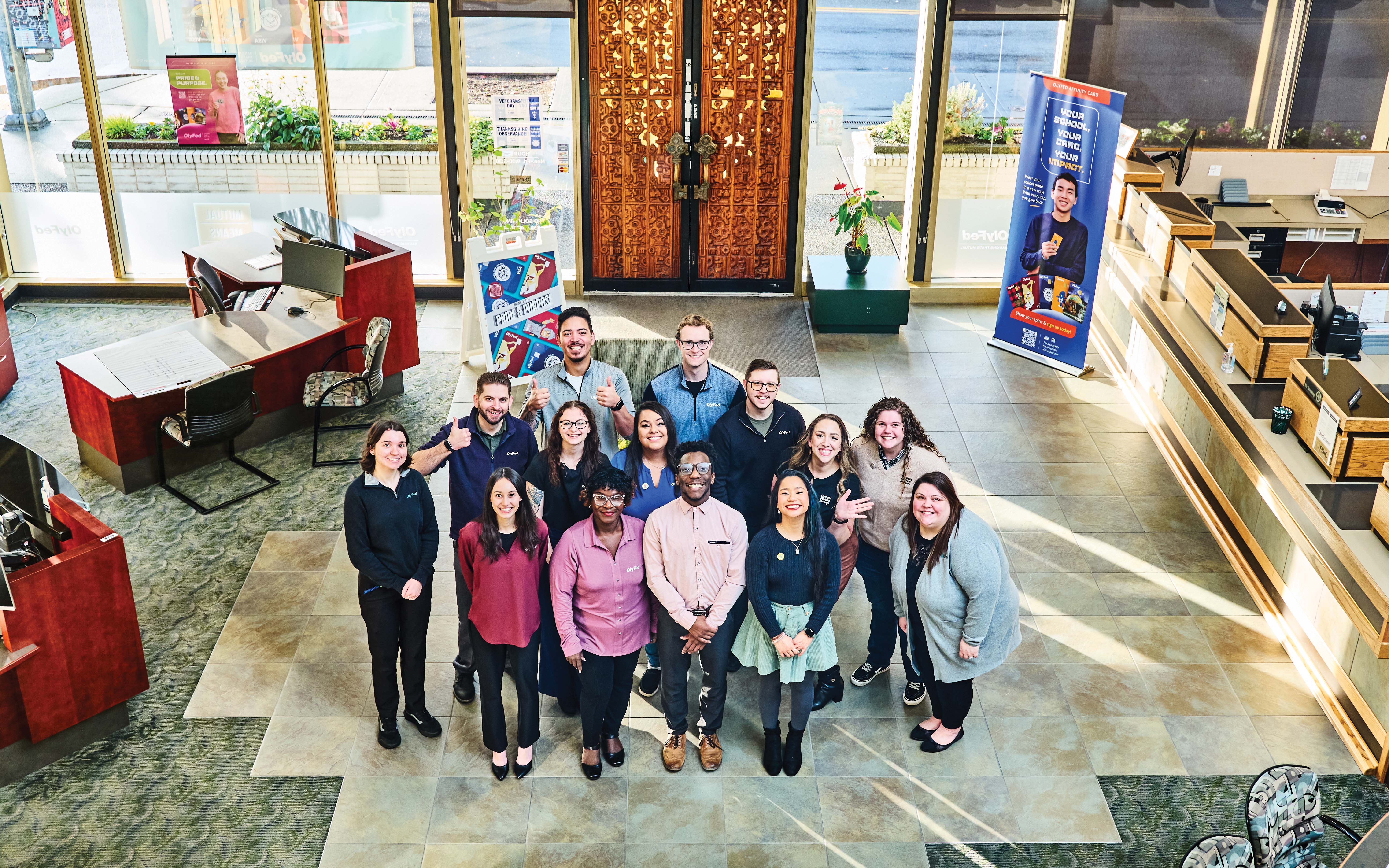Community bankers, fintech experts and consultants alike are keeping their finger on the pulse when it comes to the latest technology—with the goal of understanding what’s useful and what’s all hype. Assessing the hottest new banking technology and how they’ve personally seen it used, here’s what they had to say.
Up-and-Coming Bank Technology: Separating Innovation from Hype
November 03, 2025 / By Don Sadler
Community bankers, fintech experts and consultants alike are keeping their finger on the pulse when it comes to the latest technology—with the goal of understanding what’s useful and what’s all hype. Assessing the hottest new banking technology and how they’ve personally seen it used, here’s what they had to say.
Whether you’re a community bank CEO, CTO or an employee who simply works with technology every day, you know that technology is changing so fast that it can be hard to keep up.
To help get a handle on things, we spoke with ICBA experts, fintech leaders and community bank innovators to get a sense of what’s going on with bank technology today and what might be coming over the next couple of years. This is what they told us.
Wayne Miller
Executive vice president and chief innovation officer, ICBA
One of ICBA’s main responsibilities is to help ensure that community banks have access to the same technology opportunities as large banks. To this end, ICBA launched the ThinkTECH Accelerator program eight years ago to help level the technology playing field for community banks.
“With each community bank operating a business model unique to their local community, there are any number of approaches to bank technology,” says ICBA executive vice president and chief innovation officer Wayne Miller.
Miller says community banks can always look to their back office, where there are opportunities to automate redundant and repetitive practices that take up staff time and resources that could be better dedicated elsewhere. Often, these kinds of tech upgrades can mitigate risk in addition to promoting efficiencies.
AI has been a part of the banking industry for decades now, with predictive analytics playing a role in fraud detection and credit scoring, for instance. The next frontier in AI, Miller says, involves banks using the valuable data they already hold alongside AI tools to drive better customer experiences, both internally and externally.
“It’s important for community banks to recognize that AI needs data to perform its job or task,” Miller says. “Community bankers should understand the value of the data they hold and how it can help their bank to perform better and improve the customer experience.”
Richard Rotondo
Chief digital strategist and consultant, Digital Vision Banking
In 2022, as VP and digital bank manager of American Commerce Bank in Bremen, Georgia, Richard Rotondo helped launch a digital banking division under a new brand and identity: Monesty. (Learn more about Monesty in Independent Banker’s May 2023 article.) That project generated $20 million in deposits in the first year. Now, Rotondo has forged a new career encouraging community banks to pursue a similar path.
As chief digital strategist and consultant at his consulting firm, Digital Vision Banking, Rotondo helps community banks ensure their online and mobile banking experience is top-notch before getting too caught up in hyped new technologies.
“Although it has been somewhat commoditized over the past couple of years, online digital account opening is critical for both deposit generation and loan origination,” says Rotondo. “Customers, especially young people, want an easy onboarding option where they don’t have to walk into a branch to open an account. If they can’t bank on their phone, they’re not interested.”
Another benefit of online account opening is that it allows community banks to expand beyond their physical footprints. “Many small community banks in rural areas are only doing business within a 10- or 20-mile radius of their branches,” says Rotondo. “Digital account opening lets them onboard new customers from outside this radius.”
Monesty was no more than a website that Rotondo and his assistant ran with limited involvement from the back-office staff. “The technology did the rest,” he says. “With a national OCC charter, we could do business and advertise nationwide. I think many community bankers need to wrap their minds around the fact that not every customer has to walk into a branch to open an account.”
Rotondo believes community banks should put to work the vast amounts of customer data they possess. “AI can help community banks use this data to target niche markets more effectively and make personalized offers to these customers before they even ask,” he says.
What tech isn’t worth the hype?
When fintech leaders and innovators we spoke to identified technologies they believe are being overhyped, stablecoin was at the top of the list.
“Some people believe that stablecoins are going to completely disintermediate and get rid of banks or replace all payments, but that’s an over-expectation,” says Christian Ruppe, senior vice president and chief innovation officer of Colony Bank in Fitzgerald, Georgia. “The problem is that there are too many stablecoins right now, and trust always comes into play.”
Chatbots were also mentioned as an overhyped technology for community banks. “Part of what makes community banks unique is the human touch,” says Steve Shillingford, CEO of DeepSee, a fintech firm that creates AI agents built for banking. “I don’t think most community bank customers want to be chatting with a bot on their computer screen. Instead, they want to visit the branch and talk to a live human being.”
Ruppe concurs. “A lot of banks are talking about using chat, but we don’t want to release a technology that’s going to encourage our customers to talk to their banker less. We want to use technology that builds customer relationships.”
Brian Bauer
CEO, Revio Insight
From his perspective as CEO of Revio Insight, a 2023 ICBA ThinkTECH Accelerator cohort member, Brian Bauer recognizes that compared with community banks, big banks have much larger budgets to devote to technology like AI. While it’s not realistic for community banks to follow the same technology playbook as megabanks, he says that “community banks can use AI and analytics to maximize the relationship strengths they enjoy over big banks.”
One example is by using AI and analytics to augment human relationships or, in other words, to inform bankers about where they should be focusing their targeted outreach efforts to grow wallet share. “Some of the low-hanging AI fruit involves using it to improve client engagement and boost efficiency,” says Bauer. However, what he calls “noisy data” presents a challenge to community banks. “Data generated by AI is often unstructured and uncontextualized, so traditional analytics is needed to make sense of the data so it’s usable.”
Studies have demonstrated how much more it costs to get a new customer than to keep the one you already have. But Bauer believes many banks aren’t doing enough to stop customer leakage—or worse, they don’t even know they’re losing customers.
“This is one of the biggest opportunities I see with analytics and AI: giving community banks data visibility to retain deposits and engage customers with relevant offers they’re actually interested in,” says Bauer. “You don’t need to just guess at what your customers want when you have the data that allows you to make targeted product offers.”
Carson Lappetito
President, Sunwest Bank
Sunwest Bank in Sandy, Utah, used Revio Insight to identify customers with competitor card relationships when it was launching a commercial credit card. The insights helped the $3.7 billion community bank quickly capture over $50 million in card volume while also raising deposits in an incredibly competitive climate.
“From a technology standpoint, the banking industry mostly operates with a rearview mirror perspective,” says Carson Lappetito, Sunwest Bank president. “This needs to shift to a windshield perspective. Making use of proactive data analytics gives banks the insights they need to look forward instead of backward.” When asked to rank their customers in terms of value, bank executives usually rank them by deposits or loans, says Lappetito. “And it’s always a static average balance of the deposit account,” he says. “However, a bank might have customers that don’t carry large balances but still drive huge transaction or fee revenue, but the bank isn’t classifying them as a large customer. Data analytics tells you far more about your customers than historical reporting reveals.”
Good data analytics is critical to building strong AI models. “You have to get your data house in order, which is easier for community banks than for big banks, [because they have fewer systems and less data to centralize], as long as they put the effort into it,” says Lappetito. This is why he believes that AI presents one of the greatest opportunities in many years for community banks.
“What AI is doing for efficiency is just unbelievable, and not just in the back office,” he says. “We’re using AI for all of our process automation on the front end to make sure our salespeople are out meeting with customers instead of sitting behind desks crunching data. We’ve built AI agents that do huge swaths of this work.”
Sunwest Bank has also built its own proprietary fraud prevention tool: Bank Fraud Alert. “When check fraud started picking up materially a couple of years ago, we were very disappointed in the fraud prevention tools available,” says Lappetito. “The user experience was terrible, and it was too expensive.”
Even with check fraud on the rise, the adoption rates for fraud prevention tools like positive pay are low. Only about one out of three financial institutions say they are satisfied with their bank’s positive pay adoption rate, according to the 2025 AFP Payment Fraud and Control Survey.
“We decided that the best way to get customers to use fraud prevention tools was to build a better user experience and offer it at a low cost or for free depending on the balances maintained,” says Lappetito. Sunwest Bank also gives customers cybersecurity insurance as part of a product bundle that includes business checking.
Sunwest Bank has a development team that builds much of the bank’s proprietary technology. Lappetito is also a founder of BankTech Ventures, a strategic investment fund that supports the community banking industry by sourcing and vetting best-in-class technology solutions for community bank partners. “The goal is to make sure community banks have the technology they need to be successful,” says Lappetito.

Addressing instant payments risk
Consumers today have come to expect nearly instant delivery of almost everything they buy online. With the rise of PayPal, Venmo and Zelle, this expectation has carried over to instant payments, which poses a challenge for community banks.
“Instant payments present the opportunity for instant fraud by scammers,” says Ravi Loganathan, head of banking and policy at AI risk mitigation platform Sardine and cofounder and president of its fraud data-sharing consortium Sonar.
“While large financial institutions are investing billions of dollars in fraud prevention, most community banks don’t have the infrastructure to support these kinds of payments,” he explains.
After recently completing the ICBA ThinkTECH Accelerator program, Loganathan says he’s convinced that community banks need to materially upgrade their risk infrastructure before delving deeper into instant payments or other cutting-edge tech products and features. “This will be a material challenge for community banks, based on what I’ve seen,” he says.
Loganathan would like to see a consortium of community banks come together to share risk intelligence and information about fraudsters like large tier 1 and tier 2 banks are doing.
“Fighting payment fraud is a collective team sport; no one bank can do this on its own,” he says. “Collective intelligence gathered and shared through a consortium framework can help community banks defend themselves as a group.”
Christian Ruppe
Senior vice president and chief innovation officer, Colony Bank
Christian Ruppe says he’s not one of those people who believes AI is going to take over the world. However, $3.2 billion-asset Colony Bank in Fitzgerald, Georgia, where Ruppe is the senior vice president and chief innovation officer, is implementing AI in several use cases.
“All [these use cases] have provided dramatically more value than we’re investing in the technology,” he says.
Loan onboarding, for one, would be highly labor intensive for Colony Bank without the use of AI. “Someone has to manually go through a checklist and make sure all the information matches before a loan package can be sent out,” says Ruppe. “We were going to hire an employee to do this, but instead we’re going to use AI. This frees up an employee to focus on things that are moving the bank forward instead of monotonous manual tasks.”
Ruppe meets regularly with bankers and lenders to talk about ways they can use Google’s Gemini, an AI assistant, to streamline manual tasks.
“For example, bankers are creating AI prompts that let them accomplish tasks in 60 seconds that used to take an hour,” he says. “We’re just scratching the surface and have already identified [significant] value.”
Colony Bank’s ultimate goal is to use AI to build better relationships with customers and the community. “Instead of spending an hour poring over a loan document, a banker can now spend that hour out in the community looking for people and businesses that we can help,” says Ruppe. “AI is helping us spend more time serving our customers and community.”
Ruppe believes some community banks are having “paralysis by analysis” when it comes to implementing new technology.
“They just don’t know where to start,” he says. “No matter how technically capable they feel, community banks should start trying and testing new technologies they believe will help their core business thrive.”

AI and loan underwriting: Be cautious
While many community bank leaders and innovators are excited about how artificial intelligence could be used to boost efficiency and performance, there’s one area in which almost all agree that AI should have a very limited (if any) role: loan underwriting.
“We’re in the very early stages of this right now,” says Ravi Loganathan, head of banking and policy at AI risk mitigation platform Sardine and cofounder and president of its fraud data-sharing consortium Sonar.
“A lot of work needs to be done,” he says, “and a lot more controls need to be put in place to ensure that there is no adverse impact on bank customers.”
Loganathan notes the models that drive AI decisioning don’t have adequate controls to do this in a thoughtful way. “This is what’s holding things back,” he says. “Banks and regulators are going to have to collaborate to make sure the proper controls are in place before loan underwriting can be fully autonomous, and this is going to take some time.”
“One of the biggest risks community banks face is not using technology correctly or being responsible with it,” says Christian Ruppe, senior vice president and chief innovation officer for Colony Bank in Fitzgerald, Georgia. “We’re very careful in making sure that no loan decisions are being made by AI.”
Steve Shillingford
CEO, DeepSee
DeepSee, a fintech firm that creates AI agents built for banking, delivered the platform Colony Bank uses to streamline loan onboarding.
“This is one of the top leverage points for deploying AI technology,” says Steve Shillingford, CEO of DeepSee. “Employees are managing AI agents instead of doing the manual work themselves, which is resulting in huge efficiency gains for community banks.”
AI can also help with check fraud protection. “Fraudsters are getting very creative with how they’re altering checks, but AI is really good at image recognition and comparison,” says Shillingford. “This can help community banks lower their check fraud losses.”
Treasury quoting is another area where community banks can use AI to boost efficiency.
“There’s a narrow window where community banks can win or lose the opportunity for new treasury business,” says Shillingford. “By using AI to streamline the documentation and quote process, banks can substantially boost their win rate.”
Subscribe now
Sign up for the Independent Banker newsletter to receive twice-monthly emails about new issues and must-read content you might have missed.
Sponsored Content
Featured Webinars
Join ICBA Community
Interested in discussing this and other topics? Network with and learn from your peers with the app designed for community bankers.
Subscribe Today
Sign up for Independent Banker eNews to receive twice-monthly emails that alert you when a new issue drops and highlight must-read content you might have missed.
News Watch Today

Join the Conversation with ICBA Community
ICBA Community is an online platform led by community bankers to foster connections, collaborations, and discussions on industry news, best practices, and regulations, while promoting networking, mentorship, and member feedback to guide future initiatives.













